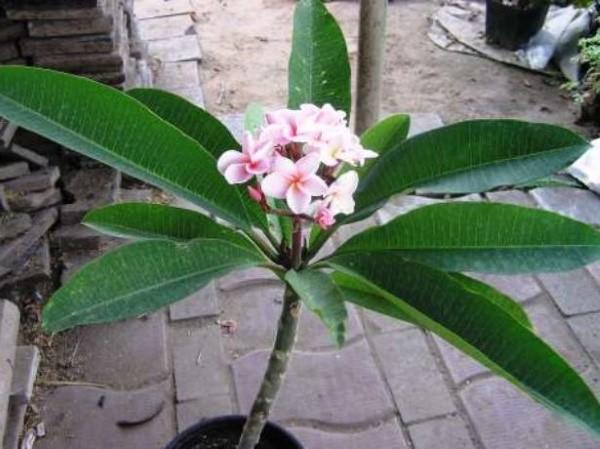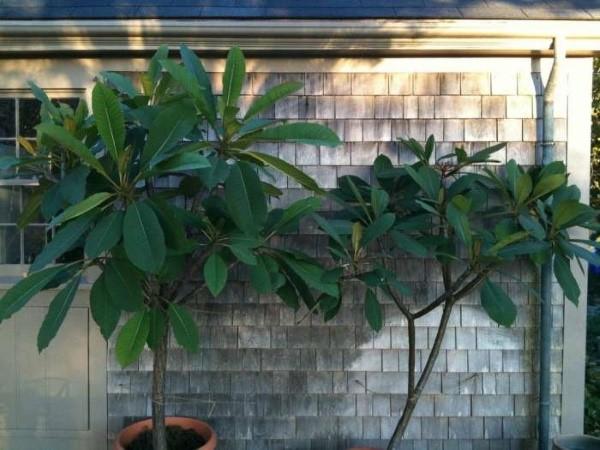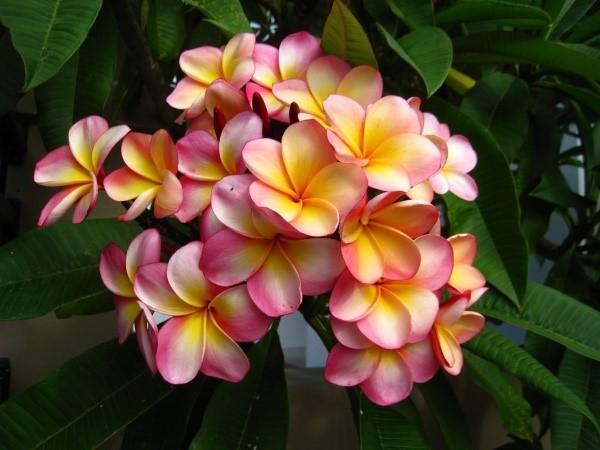Plumeria from seeds at home - we grow a tropicana without much hassle
 Those who love large plants and have enough space for them will surely like the plumeria. One of the easiest ways to get this flowering tree is to grow plumeria from seeds at home. Seeds are distinguished by good germination, and the plants themselves develop quite quickly.
Those who love large plants and have enough space for them will surely like the plumeria. One of the easiest ways to get this flowering tree is to grow plumeria from seeds at home. Seeds are distinguished by good germination, and the plants themselves develop quite quickly.
In our climate, plumeria can only be kept in greenhouses or indoors, because it is a true tropicana. Originally from the distant Caribbean islands, this exotic plant requires freezing temperatures all year round. But in the house, which in winter will provide the tree with fertile comfort and warmth, it feels good.
What is remarkable about plumeria

The second name of the culture is frangipani. Under this name, plumeria is known in Europe. And she got it thanks to an Italian perfumer who created perfumes from her flowers.
At the first glance at this plant, your attention will immediately be drawn by its gorgeous leaves. Long, with slightly pointed tips and a smooth dark green surface, painted with white veins. Some growers claim that they look like leaves. ficus... To others, the characteristic pattern of veins resembles a white-necked spurge. Be that as it may, the plumeria has a much larger leaf plate, while its reverse side is lighter. For the winter, the tree can shed its foliage in whole or in part, from the lower half of the shoots.
Plumeria bloom
 But the main advantage of this tropical guest is flowering. The flowers themselves are not very large, only up to 4 cm in diameter, but they are collected in dense inflorescences. Each flower looks like an asterisk, has 4 to 7 petals and is brightly colored. Plumeria with white and pink inflorescences look very delicate. Coral and yellow varieties will delight you and red-flowered plumeria will surprise you with the richness of colors. But that's not all: during the flowering period, which at home can be several times a year, a delicate aroma hovers over the bush. It is somewhat similar to the smell of our jasmine, the same deliciously sweet. This is why many flower growers get themselves a Tropicana.
But the main advantage of this tropical guest is flowering. The flowers themselves are not very large, only up to 4 cm in diameter, but they are collected in dense inflorescences. Each flower looks like an asterisk, has 4 to 7 petals and is brightly colored. Plumeria with white and pink inflorescences look very delicate. Coral and yellow varieties will delight you and red-flowered plumeria will surprise you with the richness of colors. But that's not all: during the flowering period, which at home can be several times a year, a delicate aroma hovers over the bush. It is somewhat similar to the smell of our jasmine, the same deliciously sweet. This is why many flower growers get themselves a Tropicana.
The scent of flowers becomes richer in the evening and at night.
Plumeria from seeds at home: planting features
 Perhaps the most difficult thing when growing plumeria seed will not be the process itself, but the acquisition of seeds. It is almost impossible to see them in our stores. But on the Internet there are many foreign sites where you can choose the right variety for yourself. Another option: ask around among collectors who are also often fond of breeding frangipani.
Perhaps the most difficult thing when growing plumeria seed will not be the process itself, but the acquisition of seeds. It is almost impossible to see them in our stores. But on the Internet there are many foreign sites where you can choose the right variety for yourself. Another option: ask around among collectors who are also often fond of breeding frangipani.
When buying white plumeria seeds, be prepared for it to bloom with pinkish buds. Varietal traits are hardly transmitted by seed propagation.
But is that bad? After all, you have a chance to get “your”, unique, plumeria. But the red varieties, most likely, will remain the same, just slightly changing the shade.
How to prepare seeds for sowing
 Plumeria seeds are very similar to maple "airplanes". At the end of flowering, a pod ripens in place of the bud, filled with many long lionfish. At the bottom of them is the seed itself.
Plumeria seeds are very similar to maple "airplanes". At the end of flowering, a pod ripens in place of the bud, filled with many long lionfish. At the bottom of them is the seed itself.
Seeds ripen for a very long time, up to 9 months.
To speed up the germination of seeds, they must be germinated before sowing. But keep in mind that you should never cut off the lionfish. She is the part of the seed that must be on it until the sprout appears.
There are two ways to germinate seeds:
- Soak the seeds in the growth stimulant solution for a quarter of an hour. Take a couple of paper towels, moisten copiously with water and place on a saucer. Place them on a damp cloth and cover with a second layer of paper. Place the saucer in a plastic bag and place on the battery. Seeds should germinate in a warm place. Look in and dampen the paper periodically to keep it from drying out.

- Heat the water a little and soak the seeds for 2-3 hours. It is important to maintain the water temperature at all times. After this time, immerse the lionfish in hydrogen peroxide for a few seconds. Let them dry a little and repeat the procedure 2 more times. Cut off a thin layer of foam and use a knife to make through holes in it according to the number of lionfish. You can take a cotton pad or foamiran. Insert the seeds into the holes so that the lionfish itself is on top. Pour warm water into a saucer and dip the foam with the seeds. The part of the lionfish, where the seed itself is located, must be in the water. It is there that the roots are formed.

Subtleties of planting plumeria from seeds
 The seeds germinate quite quickly, and after a week you will see small white roots. Plumeria can now be planted in pots. It is convenient to use separate containers at once, especially since the planting material is quite large. The soil for plumeria seedlings should be nutritious and loose so that water does not stagnate in it.
The seeds germinate quite quickly, and after a week you will see small white roots. Plumeria can now be planted in pots. It is convenient to use separate containers at once, especially since the planting material is quite large. The soil for plumeria seedlings should be nutritious and loose so that water does not stagnate in it.
You can make a similar soil mixture yourself by mixing:
- 2 shares of humus;
- 1 beat each vermiculite, peat and sand.
If there is no humus, leafy soil from the garden is also suitable, but do not forget to ignite it in the oven for disinfection.
No desire to mess around with compiling the substrate? Buy soil for cacti or adeniums - it will work too.
Small plastic pots with drainage holes are suitable for growing plumeria seeds at home. Petunia seedlings are often sold in such containers. Pour soil mixture into them, but do not compact.
In the center of the flowerpot, make a hole with a stick and plant one seed in it. You need to plant in the same way as you put the seeds for germination - lionfish up. Only 1/3 of it should remain above the ground. Press down gently around the seed and spray liberally. It remains only to cover with a jar or a bag to make a greenhouse. In this form, the plumeria will remain until the appearance of young shoots. Better yet, leave the seedlings in the greenhouse until they form a couple of true leaves.
As soon as the lionfish bent slightly to the side - wait, one of these days a sprout will appear.
Plumeria seedlings care
 During the greenhouse period, do not forget to regularly ventilate the crops - plumeria does not like high humidity. It also has a negative attitude to excess moisture in the soil. Therefore, spray the substrate as needed without flooding, otherwise it will sour.
During the greenhouse period, do not forget to regularly ventilate the crops - plumeria does not like high humidity. It also has a negative attitude to excess moisture in the soil. Therefore, spray the substrate as needed without flooding, otherwise it will sour.
When the seedling of lionfish grows up to 6-7 cm and forms 2-3 true leaves, dive it into more spacious containers. It is not worth taking too large dishes for now - a flowerpot with a diameter of up to 10 cm will be enough.It will be possible to increase the diameter of the pot by 2-3 cm gradually, every spring by transplanting plumeria.
Do not use clay pots. Plant roots are very fond of being fixed on the walls. Then it will be impossible to transplant the bush without injuring the roots.
There is one problem you may encounter when growing plumeria from seed.Lionfish do not always fully open - sometimes they remain on the tops of the seedlings. Do not leave seedlings in trouble, because the plants themselves cannot always cope with this. A tightly seated lionfish prevents the seedling from growing and can even completely stop its development. Remove the lionfish yourself, but carefully. First, wrap it with a wet cotton swab and let it soften. Then pick it up with a pencil or a toothpick and free the plant.
 In the future, caring for plumeria from seeds will consist of organizing the correct watering regime and keeping conditions. So that your pet can bloom in 3-4 years, keep it cool in winter and water it occasionally. In the spring-summer period, it needs regular watering and fertilizing with mineral complexes every 2 months.
In the future, caring for plumeria from seeds will consist of organizing the correct watering regime and keeping conditions. So that your pet can bloom in 3-4 years, keep it cool in winter and water it occasionally. In the spring-summer period, it needs regular watering and fertilizing with mineral complexes every 2 months.
With this mode, you will have a beautiful meter-long tree and will delight you with a lush basket of bright inflorescences. So don't let the exotic seed species and the overseas nature of the plumeria scare you. Plant plumeria seeds at home and enjoy the results of your labors!